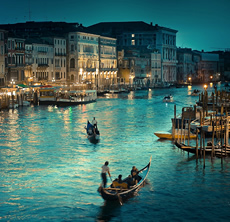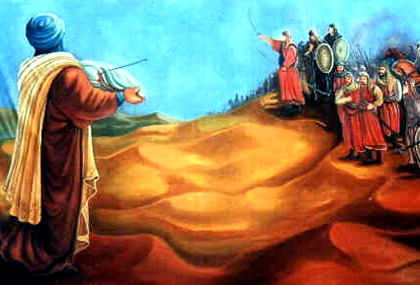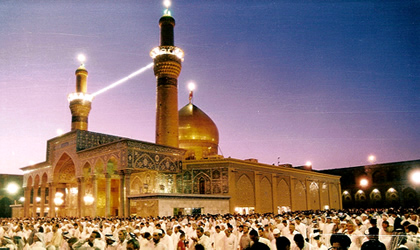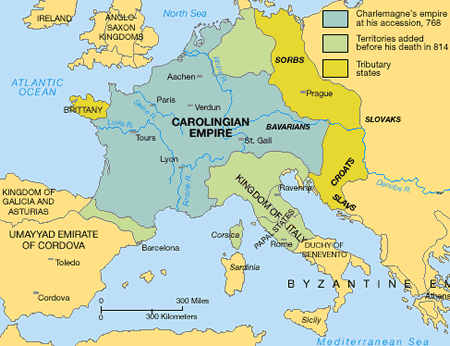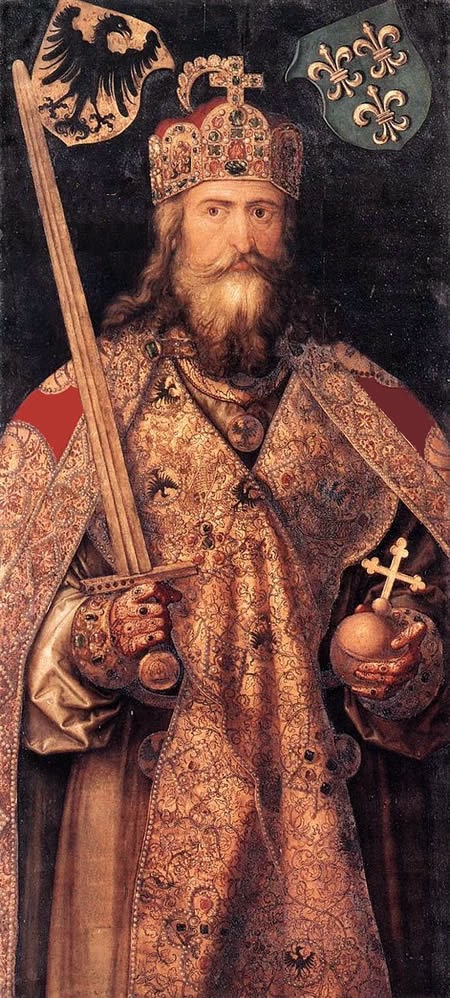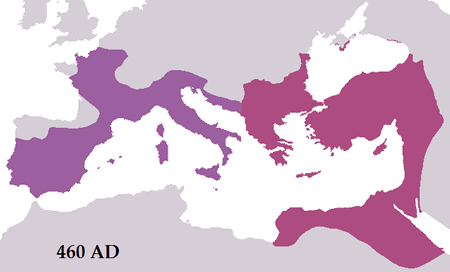 |
| Roman empire in 460 AD |
The city of
Constantinople, or Byzantium, was founded, according to legend, in 667 b.c.e., by Greeks from Megara and gradually rose in importance during the
Roman Empire. Its initial importance was its position on the trade routes in the eastern Mediterranean, especially its close access to the land routes to Persia, Central Asia,
India, and China, as well as guarding the entrance to the Pontus Euxinus (Black Sea).
During the second century the Roman Empire had grown so substantially that there were moves to split it into an eastern and a western empire. This concept was introduced by
Diocletian, who looked to the past for ideas to resolve the problems facing the Roman Empire.
His idea was that two emperors (each known as an augustus) would rule the two halves of the Roman Empire. Each augustus would then nominate a younger man, known as a caesar, to share the ruling of the empire and succeed to the post of augustus. This reduced the Roman emperors to the equivalent of chief executive officers who nominated their successors.
Diocletian then moved his capital to Nicomedia in modern-day Turkey. The idea did work briefly, but there were enormous problems, and it was left to Emperor Constantine the Great to rework the system. In 330 Constantine established the eastern capital at Byzantium, which he called Constantinople. He also reintroduced a hereditary succession to try to stop the strife caused by contending caesars.
Although his successors ruled over what became known as the Byzantine Empire, those living in Constantinople never saw themselves as Byzantines, the name coming from the Thracian-Greek name for the city. Instead they regarded themselves as Romans (or Romaioi), and direct lineal descendants of the power, traditions, and prestige of the Roman Empire.
Origins of the Byzantine Empire
Essentially the Byzantine Empire owes its origins to Constantine the Great who ruled from 324 to 337. The emperor drew up plans for enlarging his city with the building of a large palace, a forum, a hippodrome, and government departments. To protect the city from attack, Constantine also supervised the building of large walls across the isthmus.
 |
| constantinople |
Constantine died at Ancyrona, near Nicomedia, and his body was brought back to Constantinople, where it was buried. He was then succeeded by his eldest son, Constantius (or Constantine II), who reigned from 337 to 340. He was succeeded by his brother Constantius II, who ruled until his death in 361 and as sole emperor from 353 to 361. He died of fever near Tarsus in modern-day Turkey.
The next emperor was
Julian the Apostate, (r. 361–363). He was the son of Julius Constantius, half brother of Constantius II. The last pagan emperor, he tried to restore religious traditions of Rome in an effort to try to restore his empire to its former glory.
When Julian died in a battle against the
Sassanid Persians, a prominent Roman general, Flavius Iovianus, was elected Roman emperor, becoming the emperor Jovian. He was a Christian and is best remembered for being outmaneuvered in a peace agreement with the Sassanids. He died on February 17, 364, after a reign of only eight months.
 |
| Byzantine flag |
His successors were Valentinian I, another successful general, and his younger brother Valens, Valens becoming emperor of the Eastern Roman Empire. Valens reigned for 14 years, and his first task was to withdraw from Mesopotamia and parts of Armenia, which Jovian had ceded to the Sassanids. However, Valens also had to deal with a revolt by Procopius, a maternal cousin of Julian.
Procopius managed to raise two army legions to support his proclamation as emperor, and Valens considered abdicating to prevent a civil war. When Valens sent two legions against Procopius, both mutinied and joined the rebellion. However, by the middle of 366 Valens had managed to raise a large enough army to defeat the forces of Procopius at the Battle of Thyatira. Procopius was captured soon afterwards and executed.
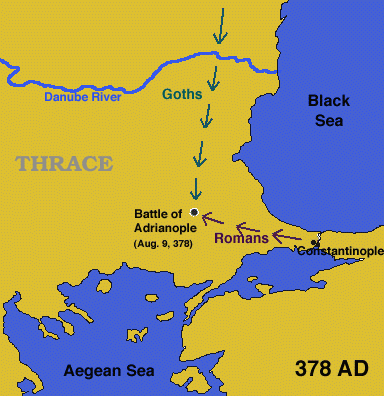 |
| Battle of Adrianople |
The revolt of Procopius encouraged the Goths to attack the Eastern Roman Empire. This meant that Valens had to lead his successful army north, and after defeating a Goth army, he concluded a peace treaty that allowed Roman traders access to the lands controlled by the Goths. War with Sassanid Persia broke out, forcing him to lead his armies back toward Persia.
His campaign was cut short when the
Visigoths threatened the northern frontier. They had lost lands to the Huns and were anxious to compensate themselves with Roman lands. Eventually the Visigoths allied with the Huns, and along with the Ostrogoths, attacked the Romans. A massive Byzantine army moved against them, leading to the
Battle of Adrianople, August 9, 378.
The Goths and their allies destroyed the Roman army, and Valens was killed during the battle. It left the Byzantines exposed, and with Gratian, the 19-year-old nephew of Valens, as the emperor of the Western Roman Empire, there was the need for a strong ruler to save the empires.
Theodosius I
Theodosius I, born in Galicia, in modern-day Spain, was the son of a senior military officer who was executed after being involved in political intrigues. Theodosius was made commander of Moesia, on the Danube (in modern-day Serbia and Bulgaria). After Adrianople, Gratian appointed him as the co-augustus for the East, and he co-ruled with Gratian and Valentinian II.
 |
| Emperor Theodosius I |
On a political level, Theodosius was a Christian and made Christianity the official state religion of the Roman Empire. In 381 he helped convene the second general council of the Christian Church, held at Constantinople, where some of the decisions of the
Council of Nicaea in 325 were confirmed.
The main task of Theodosius was to ensure the military survival of the Roman Empire, and he immediately went to war in the Balkans with the Sarmatians. He had defeated them six years earlier, and another victory led to his being proclaimed as co-emperor on January 19, 379.
He was given the provinces of Dacia (modern-day Romania) and Macedonia, both areas having been attacked many times in the previous decades. Living at Thessalonica, Theodosius built up his army. To raise more soldiers, he allowed for Teutons to be recruited, rewarding many of them with senior administrative positions.
Theodosius also sought a compromise with the Visigoths and assigned lands to the Goths in the Balkans in return for peace. It was the first time that an entire people were settled on Roman soil and able to maintain their autonomy. It avoided war with the Goths, many of whom converted to Christianity.
These moves were unpopular with some in Rome, and later historians have blamed these positions on making Rome vulnerable to attack. However, Theodosius was able to use this newfound military force to great effect. When a usurper,
Maximus the Confessor, gained support in the Western Roman Empire and invaded Italy, Theodosius was the only commander with enough soldiers to check his advances.
In 378 he defeated Maximus and, later, the forces of another usurper, Eugenius. Theodosius crushed his rebellion at the Battle of Frigidus on September 5–6, 394. By this time Theodosius was sole emperor. He was subsequently known to history as Theodosius the Great.
When Theodosius I died, his younger son, Honorius, succeeded him in the West, and his eldest son, Arcadius, succeeded him in the East. Arcadius appears to have been a weak ruler, and for much of his reign, a minister, Flavius Rufinus, a politician of Gaulish ancestry, made the decisions.
With Honorius being dominated by his minister Flavius Stilicho, the position of emperor was in danger of becoming symbolic. According to some accounts, it was rivalry between the ministers that led to Stilicho having Rufinus assassinated by Goths.
However, a new minister, Eutropius, took over for Rufinus until, in 399, the wife of Arcadius persuaded her husband to remove Eutropius, who was later executed. The Praetorian commander, Anthemius, took over, with Arcadius retreating from the political scene until his death on May 1, 408. His son Flavius Theodosius, who became Theodosius II, succeeded him.
Theodosius II was only seven when he became emperor, but on the reputation of the military builtup by his grandfather, the boy had a trouble-free minority, and the empire remained safe from attack through his long reign, which ended with his death on July 28, 450.
His older sister, Pulcheria, whose interpretation of Christianity was anti-Jewish, heavily influenced Theodosius. Under Pulcheria’s influence, the Christian Church condemned the Nestorian viewpoint of the dual nature of Christ as heretical, and Nestorius, its proponent, was exiled to Egypt.
In 425 the University of Constantinople was founded as a center for Christian learning. Theodosius II is best remembered for his codification of the laws of the Roman Empire. In 429 he ordered that copies of all laws be brought to Constantinople, and nine years later the Codex Theodosianus was published.
Although the Eastern Roman Empire was safe, the Western Roman Empire crumbled during this period, resulting in much power reverting to Constantinople. During the last years of the reign of Theodosius II, the Byzantine Empire came under attack from Attila the Hun, and the Byzantines responded by paying large tribute to the Huns to stop the attacks.
On the death of Theodosius II in 450, Pulcerhia chose as her brother’s successor Flavius Marcianus, her husband, who became Emperor Marcian. Marcian stopped the payments to the Huns, who, by this time, were more concerned with attacking Gaul and Italy. Marcian also fortified Syria and Egypt to prevent attacks and was thought to have distanced himself from events in the Western Roman Empire.
It appears that Marcian may have been involved in the death of Attila in 452, even though he did not send aid to Rome, which was sacked by the Vandals in 455. Marcian and his wife are both recognized as saints by the Eastern Orthodox Church.
Marcian died in 457, and Flavius Valerius Leo Augustus (Leo the Thracian) became the new emperor. He was a successful general who had led campaigns in the Balkans and against the Goths. Leo I sent a large army against the Vandals, under the command of his brother-in-law Basilicus, but it was decisively defeated in 468.
He died in 474 and was succeeded by his seven-year-old grandson, Leo II, who died 10 months later. Leo II’s father, Zeno, became emperor. Initially he had success leading his armies against the Vandals and the Huns in the Balkans.
In January 475 he was deposed by Basilicus, who took control of Constantinople for his reign, which lasted 19 months. In August 476 Zeno took over again, exiling Basilicus and his wife and son to Cappadocia, where they died from exposure. Zeno managed to build up the Byzantine finances. When he died in April 491, his widow, Ariadne, chose an important courtier, Anastasius, to succeed him.
Anastasius was involved in the Isaurian War from 492 to 496, where forces loyal to Longinus of Cardala, a brother of Zeno, revolted. Many rebels were defeated at the battle of Cotyaeum, and although guerrilla war continued for some years, Anastasius was never in serious danger from them again. From 502 to 505 he was involved in a war with the Sassanid Empire of Persia.
Initially the Sassanids were victorious, but the war ended in a stalemate. Anastasius then spent much of the rest of his reign building defenses. These included the Anastasian Wall, which stretched from Propontis to the Euxine, protecting the western approaches to Constantinople. Anastasius died on July 9, 518, the last Roman or Byzantine emperor to be deified.
Justin I was nearly 70 when he became emperor. He was illiterate but was a successful career soldier. The last years of his reign saw attacks by Ostrogoths and Persians. In 526 he formally named Justinian, his nephew, as co-emperor and his successor.
Justinian I
Justinian I was one of the most famous Byzantine rulers and is best remembered for his legal reforms that saw the establishment of a new legal code. He gained a reputation for working hard, being affable but unscrupulous when necessary. His early military moves were to try to regain the lost lands of Theodosius I. He failed in this but quickly gained a reputation for surrounding himself with advisers who achieved their status through merit.
One of these was Tribonian, who had the task of codifying the law—the first time all of Roman law was written down in one code. At the same time Justinian’s general Belisarius decided to launch an attack on the Sassanid Persians and against the Vandals in North Africa, recapturing
Carthage. In what became known as the Gothic War, Belisarius retook Rome in 536, and four years later he took the Ostrogoth’s capital, Ravenna. The 540s saw parts of the Byzantine Empire ravaged by bubonic plague.
In 565 Justinian I died and his nephew Flavius Iustinius became Emperor Justin II. The Byzantines lost land to the Sassanids in a disastrous war with Persia. Justin II became troubled by mental problems and may have been going senile. He appointed a general named Tiberius as his successor.
Tiberius II Constantine was the first truly Greek emperor, and he continued the war with the Persians in Armenia. He was succeeded in 582 by a prominent general, Mauricius, who subsequently married the daughter of his predecessor.
The Emperor Maurice reigned from 582 to 602, a time when the empire was constantly attacked. When the Romans intervened in a dynastic war in Persia, they were amply rewarded by the return of eastern Mesopotamia and Armenia. However, while the Byzantines were involved in Persia, the Slavs took control of much of the Balkans. In 602 a mutiny by troops led to a general called Phokas (Phocas) entering Constantinople and killing Maurice, after forcing the deposed emperor to watch the execution of five of his sons.
Phokas was from Thrace and was a successful general of obscure origins before he seized the throne. The seizing of power by Phokas was the first bloody coup d’état since Constantinople became the capital of the Eastern Roman Empire. Phokas was initially popular because he lowered taxes and introduced reforms that benefited the Christian Church. However, on a military front, the Eastern Roman Empire faced invasion, especially in the northern Balkans, and raiders did reach as far as Athens.
In addition, King Khosrow II of Persia, installed by Maurice, started to conspire against the man who overthrew him. The Persians championed a young man whom they claimed was a son of Maurice, taking over some of Anatolia. In addition, trouble brewed in Egypt and Syria. In 610 Heraclius, the exarch (proconsul) of Africa, staged a rebellion that ended with Phocas being put to death.
Heraclius I was emperor from 610 to 641 and tried to reunite the empire that was still under attack in the Balkans and from the Persians. The latter managed to capture Damascus in 613, Jerusalem in the following year, and in 616 invaded Egypt. Their raids deep into Anatolia caused Heraclius to consider moving the capital from Constantinople to Carthage, but his reorganization of the military allowed him to stop the invading forces.
Much of this centered on land grants to families in return for having them serve in the military when the empire was in danger. In 626 Constantinople itself was attacked, but in the following year at the Battle of Nineveh, the Byzantines defeated the Persians, leading to the deposing of Khosrow II of Persia and the Byzantines gaining all the land they had lost.
Heraclius started to use the Persian title king of kings, and no longer used the term augustus, preferring basileus, Greek for “monarch.” During the 630s the Arabs proved to be a major threat to the Byzantines, who were decisively defeated in the
Battle of Yarmuk in 636. Heraklonas’s two sons succeeded him, Heraklonas Constantine (Constantine III) and Constantine Heraklonas (Heraclius).
The former ruled for only four months before succumbing to tuberculosis. His younger half brother became the sole emperor; however, there were rumors that Constantine III had been poisoned, and a rebellion led to the deposing of Heraklonas four months later, and the son of Constantine III became Emperor Constans II.
Under Constans II, the Byzantines were on the retreat, having to withdraw from Egypt with the Arabs quickly capturing parts of North Africa. The Arabs also destroyed much of the Byzantine fleet off Lycia. Later the Arabs split into what became the Sunni and Shiite factions, and were unable to carry out their plan of attacking Constantinople.
Constans II was assassinated by his palace chamberlain in 668, and a usurper, Mezezius, was emperor for a year until Constans II’s son became Constantine IV and reigned until 685. By now the Arabs attacked Carthage, Sicily, and captured Smyrna and other ports in Anatolia. The Slavs also used the opportunity to attack Thessalonica. The Byzantines were able to successfully use Greek Fire against the Arabs at the sea battle of Syllaeum.
Constantine was worried that his two brothers, crowned with him as coemperors, would pose a threat to him, and he had them both mutilated. This allowed his son Justinian II to succeed to the throne (r. 685–695 and 705–711). In the interval two successful generals, Leontios and Tiberios III, were briefly emperors.
Justinian became increasingly unpopular and was killed by rebels, with Philippikos becoming emperor 711–713. He managed to stabilize the political situation and was succeeded by his secretary Artemios, who became Emperor Anastasius II. After two years a rebel leader and former tax collector deposed him, capturing Constantinople and proclaiming himself Emperor Theodosius III. He only lasted two years; a rebel commander took control of Constantinople and forced Theodosius to abdicate. He later become bishop of Ephesus.
Leo III
The new emperor, Leo III, was able to stabilize the Byzantine Empire, and he remained emperor from 717 until his death in 741. He immediately set about a reorganization of the empire’s administration. Much of this centered on the elevation of serfs to become tenant farmers.
Making alliances with the Khazars and the Georgians, he was able to defeat the Arabs. Leo III, however, is best known for his iconoclasm when, from 726 to 729 he ordered the destruction of the worshipping of images. His son, who became Emperor Constantine V, succeeded him at his death.
He reigned until 775, managing to continue with the reforms and iconoclasm of his father and also defeat the Arabs and the Bulgars. He died while campaigning against the latter and was succeeded by a son who became Emperor Leo IV. Although Leo IV only reigned for five years, he managed to send his soldiers on several campaigns against the Arabs. When he died, his son, aged only nine, became Emperor Constantine VI.
Scheming led to him being taken prisoner and blinded by his mother, who succeeded as Empress Irene, the widow of Leo IV. Her finance minister deposed her in 802. He became Emperor Nikephoros I and continued the wars against the Bulgars and the Arabs until he was killed in Bulgaria in 811.
The son of Nikephoros I became Emperor Staurakios, but he reigned only for just over two months until he was forced to abdicate. He went to live in a monastery, where he died soon afterwards. His brother-in-law then became Emperor Michael I. Eager to become popular, Michael reduced the high levels of taxation imposed by Nikephoros I. He also sought a compromise with Charlemagne.
Abdicating, he retired to a monastery, and Leo V, an Armenian, became the next emperor. He was assassinated in 820, leading to the Phrygian dynasty of Michael II coming to power. Michael II was emperor from 820 to 829, and his son Theophilos succeeded him, ruling until 842. His wife then ruled, and then his son Michael III “The Drunkard,” who was assassinated in 867, ushering in Basil I and the Macedonian dynasty.
Basil I was believed to have been of Armenian ancestry, and he lived in Bulgaria, leading an expedition against the Arabs in 866. He helped in the assassination of his predecessor and became one of the greatest Byzantine rulers. Apart from codifying the laws, he also built the Byzantines into a major military power.
His reign also coincided with the Great Schism, in which Basil determined that Constantinople should remain the center of Christianity, not Rome. Basil allied the Byzantines to the forces of Louis II, the Holy Roman Emperor.
Their combined fleets were able to defeat the Arabs, and although the Byzantines lost much of Sicily, the eastern frontier was heavily reinforced, and Arab attacks against the Byzantines were unsuccessful. When Basil died in 886, his son Leo VI succeeded him, although some accounts identify Leo VI as a son of Michael III.
Leo VI, who was the son of a mistress of Michael III and later mistress of Basil I, ended up at war with the Bulgarians, although his tactical alliance to the Magyars was successful for a period. The Byzantine defeat in 896 was a reverse that was followed by the Arabs capturing the last Byzantine-held bases on Sicily.
A Byzantine expedition tried to recapture Crete but failed, and Leo VI died in 912, succeeded by his younger brother Alexander. Emperor Alexander was extremely unpopular, and his death after a polo match ended his reign of 13 months. Leo VI’s illegitimate son then succeeded as Constantine VII in 913, inheriting a war with Bulgaria.
Constantine was deposed in 920 by Romanos I, the son of a member of the Imperial Guard who was deposed in 944, leading to Constantine VII returning as emperor. He then reigned for 14 years, and when he died, his son Romanos II became the next emperor.
As soon as Romanos II took over, he purged the court of his father’s friends, and allegations were made that he had poisoned his father to gain the throne. Although Romanos II was indolent and lazy, he left the army in the command of capable generals. He died after a reign of four years, succeeded initially by his five-year-old son, Basil II.
Nikephoros II quickly deposed Basil, reigning for six years until he was assassinated. It was during his reign, in 961, that the famous monastery complex on Mount Athos was founded. The next emperor was John I, who reigned for six years, until he died. During his reign he trained ex-emperor Basil to rule, and Basil II became emperor again, reigning for 49 years.
Basil II formed a strong alliance with Prince
Vladimir I of Kiev, and together they managed to stabilize the northern borders of the Byzantine Empire. Basil II also took back large parts of Syria, although he did not manage to retake Jerusalem. War in Thrace against the Bulgarians saw the Byzantines destroy their opponents at the battle of Kleidion on July 29, 1014. Basil II was succeeded by his younger brother, Constantine VIII, who reigned for only three years, being succeeded by Romanos III, a great-grandson of the usurper Romanos I.
As the first in a new dynasty Romanos III tried to change many aspects of Byzantine rule. He financed many new buildings, including monasteries. He abandoned plans by Constantine VII to curtail the privileges of the nobles but faced many conspiracies, which led to his overthrow after a reign of fewer than six years. Michael IV, a friend of the daughter of Constantine VIII, ascended the throne. Military reforms were pressing, with the Byzantines under attack from Serbs, Bulgarians, and, more menacingly, the Arabs.
It was also a period when the Normans were a rising military power. Michael IV defeated the Bulgarians and died in 1041, succeeded by his nephew Michael V, who only ruled for four months. Deposed, blinded, and castrated, Michael V was succeeded by Zoe, his adoptive mother.
Constantine IX, the son of a senior civil servant, ruled from 1042 until 1055. A patron of the arts, he was subject to scheming and internal revolts. He was succeeded briefly by Michael VI and then by Isaac I Komnenos. In 1059 Constantine X became emperor and inaugurated the Doukid dynasty. After his reign of eight years, his son Michael VII ruled for 11 years.
For three of those years, Romanos IV, the second husband of Constantine X’s widow, was also emperor. In 1081 Alexios Komnenos, nephew of Isaac I, restored the Komnenid dynasty. Alexios was worried about the Turks controlling the Holy Land and decided to ask
Pope Urban II for some military help from western Europe, resulting in the launching of the First Crusade.
Over the next two centuries, as battles with Turks continued over Asia Minor, the empire’s relationship to the West deteriorated. During the Crusades the empire’s lands were meant to be used as a staging ground for the war to “reclaim” the Christian holy lands, but bored, undisciplined crusaders frequently wound up sacking and pillaging Byzantine cities when they were too impatient to wait for their arrival in Muslim territories.
The Byzantine renaissance of the 12th century was an artistic and economic one—an inward-facing revival rather than a return to the sort of diplomatic fervor that had marked the empire’s earlier centuries. At the turn of the very next century, the soldiers of the failed Fourth Crusade were hired by Alexios IV, the son of the deposed Byzantine emperor Isaac II, to restore his father’s throne. Constantinople fell to the crusaders in 1204, and the Latin Empire was established to govern formerly Byzantine lands, with many territories apportioned to
Venice.
The Byzantine Empire was officially dissolved, though its culture remained much the same for the next 200 years—through shifting governments, as the Latin Empire never stabilized and was followed by brief-lived successors—until 1453, when the Ottoman Turks conquered Constantinople and all its lands.



